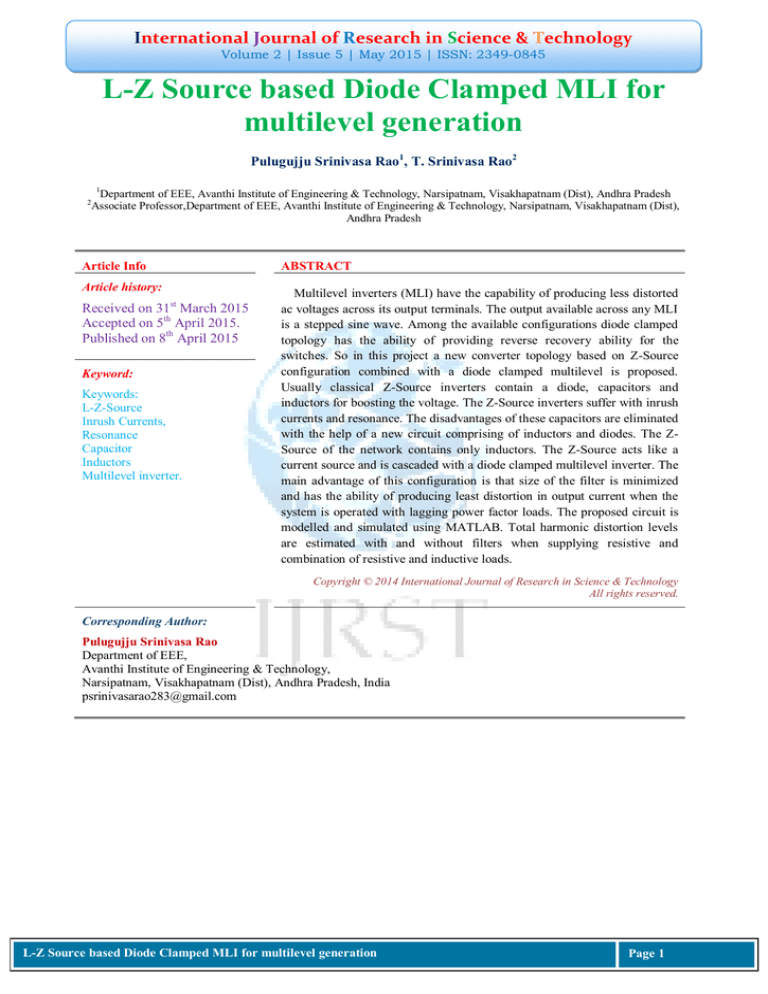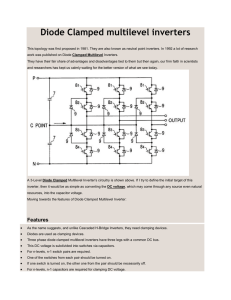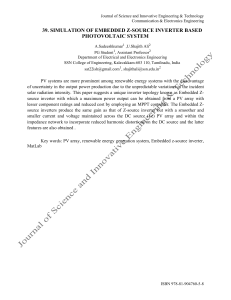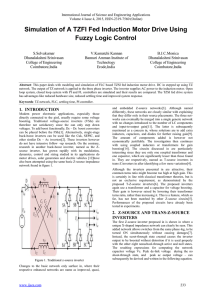
International Journal of Research in Science & Technology
Volume 2 | Issue 5 | May 2015 | ISSN: 2349-0845
L-Z Source based Diode Clamped MLI for
multilevel generation
Pulugujju Srinivasa Rao1, T. Srinivasa Rao2
1
2
Department of EEE, Avanthi Institute of Engineering & Technology, Narsipatnam, Visakhapatnam (Dist), Andhra Pradesh
Associate Professor,Department of EEE, Avanthi Institute of Engineering & Technology, Narsipatnam, Visakhapatnam (Dist),
Andhra Pradesh
Article Info
ABSTRACT
Article history:
st
Received on 31 March 2015
Accepted on 5th April 2015.
Published on 8th April 2015
Keyword:
Keywords:
L-Z-Source
Inrush Currents,
Resonance
Capacitor
Inductors
Multilevel inverter.
Multilevel inverters (MLI) have the capability of producing less distorted
ac voltages across its output terminals. The output available across any MLI
is a stepped sine wave. Among the available configurations diode clamped
topology has the ability of providing reverse recovery ability for the
switches. So in this project a new converter topology based on Z-Source
configuration combined with a diode clamped multilevel is proposed.
Usually classical Z-Source inverters contain a diode, capacitors and
inductors for boosting the voltage. The Z-Source inverters suffer with inrush
currents and resonance. The disadvantages of these capacitors are eliminated
with the help of a new circuit comprising of inductors and diodes. The ZSource of the network contains only inductors. The Z-Source acts like a
current source and is cascaded with a diode clamped multilevel inverter. The
main advantage of this configuration is that size of the filter is minimized
and has the ability of producing least distortion in output current when the
system is operated with lagging power factor loads. The proposed circuit is
modelled and simulated using MATLAB. Total harmonic distortion levels
are estimated with and without filters when supplying resistive and
combination of resistive and inductive loads.
Copyright © 2014 International Journal of Research in Science & Technology
All rights reserved.
Corresponding Author:
Pulugujju Srinivasa Rao
Department of EEE,
Avanthi Institute of Engineering & Technology,
Narsipatnam, Visakhapatnam (Dist), Andhra Pradesh, India
psrinivasarao283@gmail.com
L-Z Source based Diode Clamped MLI for multilevel generation
Page 1
International Journal of Research in Science & Technology
Volume 2 | Issue 5 | May 2015 | ISSN: 2349-0845
I. INTRODUCTION
In recent years, various Z-source inverter (ZSI)
topologies have been presented in numerous diversified
studies. Some of the studies are focused on applications,
modeling, controls, and modulation strategies, whereas
others are focused on the development of new topologies.
The ZSIs accomplish a single-stage power conversion with
buck-boost capabilities. In ZSIs, both of the power
switches in a leg can be turned on at the same time and
thereby eliminate the dead time. This significantly
improves the reliability and reduces the output waveform
distortion. Fig. 1(a) shows the classical ZSI in which the
two-port impedance network couples the main inverter
circuit to the dc source. In order to overcome the
shortcomings of the classical ZSI, the quasi-ZSI (qZSI)
shown in Fig. 1(b) and SL-ZSI shown in Fig. 1(c) were
developed in [10]–[12], and [18].
Despite the aforementioned merits, the aforementioned
ZSI topologies also show the following drawbacks: 1)
capacitors are used in the Z-source network, thus highvoltage or large capacity capacitors should be used, which
may result in large volume, cost expensive, and reducing
the life span of system; 2) it cannot suppress the inrush
current and the resonance introduced by Z-source
capacitors and inductors at startup, thus causing the
voltage and current surge, which may destroy the devices;
3) it regulates boost factor only by adjusting the shootthrough duty ratio.
To solve the aforesaid drawbacks in aforementioned
ZSI, a new ZSI topology is presented with no capacitor
and reducing inherent inrush current limitation at startup. It
can suppress the resonance thoroughly by removing
capacitor and improve the efficiency of power supply. The
operation principle and comparison with the classical ZSI
and SL-ZSI reveal the merits of the proposed topology,
and are also verified in both simulation and experiment.
Fig. 1: Conventional impedance-network inverter topologies. (a) The
classical ZSI, (b) quasi-ZSI, and (c) SL-ZSI.
II. L-Z-SOURCEI NVERTER
Different to the original ZSI, the proposed
inverter has no capacitor, and is composed of two
inductors (L1 ,L2, and L1 =L2), and three diodes (D1 ,D2,
and D3), as shown in Fig. 2. The combination of L2 − L3
− D1 − D2 − D3 acts as a switched-inductor cell. The
proposed topology provides inrush current suppression,
unlike the traditional topologies, because no current flows
to the main circuit at startup. The proposed topology also
provides a common ground for the source and inverter.
Unlike the traditional ZSIs, L-ZSI just has shootthrough zero states besides the traditional six active states.
The operating principles of the proposed inverter are also
similar to those of the classical ZSI. For the purpose of
analysis, the operating states are simplified into shootthrough and non-shoot-through states. Fig. 3 shows the
equivalent circuits of L-ZSI.
In the non-shoot-through state, as shown in Fig. 2,
D2 is on, while D1 and D3 are off. L1 and L2 (L1 = L2 =
L) are connected in series. L1 and L2 transfer energy from
the dc voltage source to the main circuit, and the
equivalent circuit is shown in Fig. 3(a). The corresponding
voltages across L1 and L2 in this state are V1_non and
V2_non, respectively. Thereby, (1) and (2) can be
contained
V1 _ non V2 _ non Vi Vdc
(1)
V1 _ non V2 _ non
(2)
From (1) and (2), (3) and (4) can be concluded
1
1
V1 _ non Vdc Vi
2
2
1
1
V2 _ non Vdc Vi
2
2
(3)
(4)
Where Vdc is the dc source and Vi is the dc-link
voltage.
Fig 2: L-ZSI with two inductors.
L-Z Source based Diode Clamped MLI for multilevel generation
Page 2
International Journal of Research in Science & Technology
Volume 2 | Issue 5 | May 2015 | ISSN: 2349-0845
III. DIODE CLAMPED MLI
Most attractive features that make multilevel inverters
to be applied in various applications are, they can generate
output voltages with extremely low distortion, draw input
current with very low distortion, generate smaller commonmode voltage thus reducing the stress in the motor bearings,
able to operate with lower switching frequency etc.
Electrical energy production from batteries gives DC output
voltage, so inverters are a compelling solution to convert
output voltage of batteries into alternative form especially
when AC loads are used. Due to advantages of multilevel
inverters over the conventional three level inverters, they
are used for renewable energy applications when AC loads
are used. A diode clamped multilevel inverter with 5 level
voltage generations is shown in Figure 4.
Fig. 3: Operating states: (a) non-shoot-through and
through state.
(b) shoot-
In the shoot-through state, as shown in Fig. 2, the
inverter side is shorted by both the upper and lower
switching devices of any phase leg. During the shootthrough state, D2 is off, while D1 and D3 are on. L1 and
L2 are connected in parallel, and inductors L1 and L2 store
energy. The equivalent circuit is shown in Fig. 3(b). The
corresponding voltages across L1 and L2 in this state are
V1 and V2, respectively, and (5) is obtained
V1 V2 Vdc
(5)
Applying the volt–second balance principle to L1
and L2, (6), (7), (8), and (9) can be obtained from (3), (4),
and (5)
1 D
(6)
Vdc
1 D
1 D
B
(7)
1 D
D2 L Ll L1 D
I L I1 I 2
Vdc
Rl L1 D
1 D V
(9)
Il
dc
Rl
Diode-clamped multilevel Inverters found
applications in the areas of static var compensation,
variable speed motor drives, and high-voltage system
interconnections. Each of the three phases of the inverter
shares a common dc bus, which has been subdivided by
five capacitors into six levels. The voltage across each
capacitor is Vin, and the voltage stress across each
switching device is limited to Vin through the clamping
diodes. The principal advantages of a diode clamped
multilevel inverter include the following: 1. All of the
phases share a common dc bus, which minimizes the
capacitance requirements of the converter. 2 .The
capacitors can be pre-charged as a group. 3. Efficiency is
high for fundamental frequency switching.
Vi
(8)
Where B is the boost factor; IL is the inductor
current; Il is the load current; D is shoot-through duty
cycle; I1 and I2 are current of L1 and L2, respectively; Rl
is load resistance; Ll is load inductance.
When Ll = 0 or load is resistive, (10) is obtained
I L I1 I 2
1 D V
dc
Rl 1 D
(10)
Fig 4: A 3 Phase Diode Clamped MLI for 5 Level volatge generation.
L-Z Source based Diode Clamped MLI for multilevel generation
Page 3
International Journal of Research in Science & Technology
Volume 2 | Issue 5 | May 2015 | ISSN: 2349-0845
IV. MODEL SIMULATION & RESULTS
Fig 5: Simulation diagram of LZ Source Inverter with 11 Level Diode
Clamped MLI
Model schematic of LZ Source based diode clamped
multilevel inverter is shown in figure 5. The multilevel
inverter is controlled with sinusoidal pulse width
modulation. The proposed circuit is simulated for different
kinds of load. The voltage available at the output terminals
of LZ Source is given in fig 6. Voltage available across the
load terminals and current through the load are presented
in figure 7 and 8 and total harmonic distortion in the output
voltage and current for a load resistance of 100 Ohm and
inductance of 1 mH are shown in fig 9 and 10 respectively.
Fig 6: Current through the inductors of LZ Source Converter
Fig 7: Voltage across load and Current through load for Load with 0.9 pf
lagging.
L-Z Source based Diode Clamped MLI for multilevel generation
Page 4
International Journal of Research in Science & Technology
Volume 2 | Issue 5 | May 2015 | ISSN: 2349-0845
Fig 10: Total Harmonic Distortion in Load Current.
V. CONCLUSION
Fig 8: Voltage across the output terminals of LZ Source.
Z Source inverters operates as current source
inverters. To enhance the current carrying ability of
inverters the z source is replaced with LZ source. This LZ
Source is coupled to a 11 level diode clamped inverter. It
has been observed that the multilevel level inverters will
give better quality output in terms of total harmonic
distortion, less distorted voltages. In the proposed
converter also the same observations are made. In addition
to the regular observations the following are achieved by
the converter specifically.
1. The converter circuit is used for loads that require
high magnitudes of currents for its loads.
2. The switches that are used in LZ Source are subjected
to less voltage stress and a uniform dc voltage is
available across the output terminals of LZ source.
3. The Voltage available across the output terminals of
configuration exhibits less total harmonic distortion,
this results in less magnitude of filters.
4. By connecting a filter across the output terminals the
distortion in output voltage and current further
reduced and give more sinusoidal voltages and
currents.
REFERENCES
Fig 9: Total Harmonic Distortion in output voltage.
L-Z Source based Diode Clamped MLI for multilevel generation
[1]. G. N. Veda Prakash and M. K. Kazimierczuk, “Small-signal
modeling of open-loop PWM Z-source converter by circuitaveraging technique,” IEEE Trans. Power Electron. , vol. 28,
no. 3, pp. 1286–1296, Mar. 2013.
[2]. F. B. Effah, P. Wheeler, J. Clare, and A. Watson, “Spacevector-modulated three-level inverters with a single Z-source
network,” IEEE Trans. Power Electron. , vol. 28, no. 6, pp.
2806–2815, Jun. 2013.
[3]. F. Guo, L. Fu, C.-H. Lin, C. Li, W. Choi, and J. Wang,
“Development of an 85-kW bidirectional quasi-Z-source
inverter with DC-link feed-forward compensation for electric
vehicle applications,” IEEE Trans. Power Electron. , vol. 28,
no. 12, pp. 5477–5488, Dec. 2013.
[4]. K. Park, K.-B. Lee, and F. Blaabjerg, “Improving output
performance of a Z-source sparse matrix converter under
unbalanced input-voltage conditions,” IEEE Trans. Power
Electron. , vol. 27, no. 4, pp. 2043–2054, Apr. 2012.
[5]. X. Liu, P. C. Loh, P. Wang, and X. Han, “Improved
modulation schemes for indirect Z-source matrix converter
Page 5
International Journal of Research in Science & Technology
Volume 2 | Issue 5 | May 2015 | ISSN: 2349-0845
[6].
[7].
[8].
[9].
[10].
[11].
[12].
[13].
[14].
[15].
[16].
[17].
[18].
[19].
[20].
[21].
[22].
[23].
with sinusoidal input and output waveforms,”IEEE Trans.
Power Electron. , vol. 27, no. 9, pp. 4039–4050, Sep. 2012.
O. Ellabban, J. Van Mierlo, and P. Lataire, “A DSP-based
dual-loop peak DC-link voltage control strategy of the Zsource inverter,” IEEE Trans. Power Electron., vol. 27, no. 9,
pp. 4088–4097, Sep. 2012.
Y. Zhou, L. Liu, and H. Li, “A high-performance photovoltaic
module-integrated converter (MIC) based on cascaded quasiZ-source inverters (qZSI) using eGaN FETs,” IEEE Trans.
Power Electron. , vol. 28, no. 6, pp. 2727–2738, Jun. 2013.
P. C. Loh, F. Gao, P.-C. Tan, and F. Blaabjerg, “Three-level
ac–dc–ac Z-source converter using reduced passive
component count,” IEEE Trans. Power Electron., vol. 24, no.
7, pp. 1671–1681, Jul. 2009.
Y. Tang, S. Xie, C. Zhang, and Z. Xu, “Improved Z-source
inverter with reduced capacitor voltage stress and soft-start
capability,” IEEE Trans. Power Electron., vol. 24, no. 2, pp.
409–415, Feb. 2009.
F. Z. Peng, “Z-source inverter,” IEEE Trans. Ind. Appl. , vol.
39, no. 2,pp. 504–510, Apr. 2003.
C. J. Gajanayake, F. L. Luo, H. B. Gooi, P. L. So, and L. K.
Siow, “Ex-tended boost Z-source inverters,” IEEE Trans.
Power Electron. , vol. 25, no. 10, pp. 2642–2652, Oct. 2010.
M. Zhu, K. Yu, and F. L. Luo, “Switched inductor Z-source
inverter,” IEEE Trans. Power Electron. , vol. 25, no. 8, pp.
2150–2158, Aug. 2010.
D. Li, P. C. Loh, M. Zhu, F. Gao, and F. Blaabjerg,
“Generalized multi-cell switched-inductor and switchedcapacitor Z-source inverters,” IEEE Trans. Power Electron.,
vol. 28, no. 2, pp. 837–848, Feb. 2013.
M.-K. Nguyen, Y.-C. Lim, and G.-B. Cho, “Switched-inductor
quasi-Z-source inverter,” IEEE Trans. Power Electron. , vol.
26, no. 1, pp. 3183–3191, Nov. 2011.
B. Axelrod, Y. Berkovich, and A. Ioinovici, “Switchedcapacitor/ switched- inductor structures for getting
transformerless hybrid dc-dc PWM converters,” IEEE Trans.
Circuits Syst. I: Fundam. Theory Appl., vol. 55, no. 2, pp.
687–696, Mar. 2008.
P.C. Loh, D. Li, and F. Blaabjerg, “Γ -Z-source inverters,”
IEEE Trans. Power Electron., vol. 28, no. 11, pp. 4880–4884,
Nov. 2013.
D. Li, P. C. Loh, M. Zhu, F. Gao, and F. Blaabjerg, “Cascaded
multicell trans-Z-source inverters,” IEEE Trans. Power
Electron. , vol. 28, no. 2, pp. 826–836, Feb. 2013.
M.-K. Nguyen, Y.-C. Lim, and Y.-J. Kim, “A modified singlephase quasi-Z-source AC–AC converter,” IEEE Trans. Power
Electron. , vol. 27, no. 1, pp. 201–210, Jan. 2012.
K. A. Corzine and R. W. Ashton, “A new Z-source DC circuit
breaker,” IEEE Trans. Power Electron. , vol. 27, no. 6, pp.
2796–2804, Jun. 2012.
M.-K. Nguyen, Y.-G. Jung, Y.-C. Lim, and Y.-M. Kim, “A
single-phase Z-source buck–boost matrix converter,” IEEE
Trans. Power Electron., vol. 25, no. 2, pp. 453–462, Feb.
2010.
K. Viswanathan, R. Oruganti, and D. Srinivasan, “Dual-mode
control of tri-state boost converter for improved performance,”
IEEE Trans. Power Electron. , vol. 20, no. 4, pp. 790–797, Jul.
2005.
F. Z. Peng, M. Shen, and Z. Qian, “Maximum boost control of
the Z-source inverter,” IEEE Trans. Power Electron. , vol. 20,
no. 4, pp. 833–838, Jul. 2005.
Karthikeyan, R.,Dr.chenthur, pandian,s.,”An algorithm for
minimizing THD in multi level inverters with space vector
modulation”,IEEE Trans. on Industrial Electronics, Vol.3,
NO.5, pp3915-3921, 2011.
L-Z Source based Diode Clamped MLI for multilevel generation
Page 6





